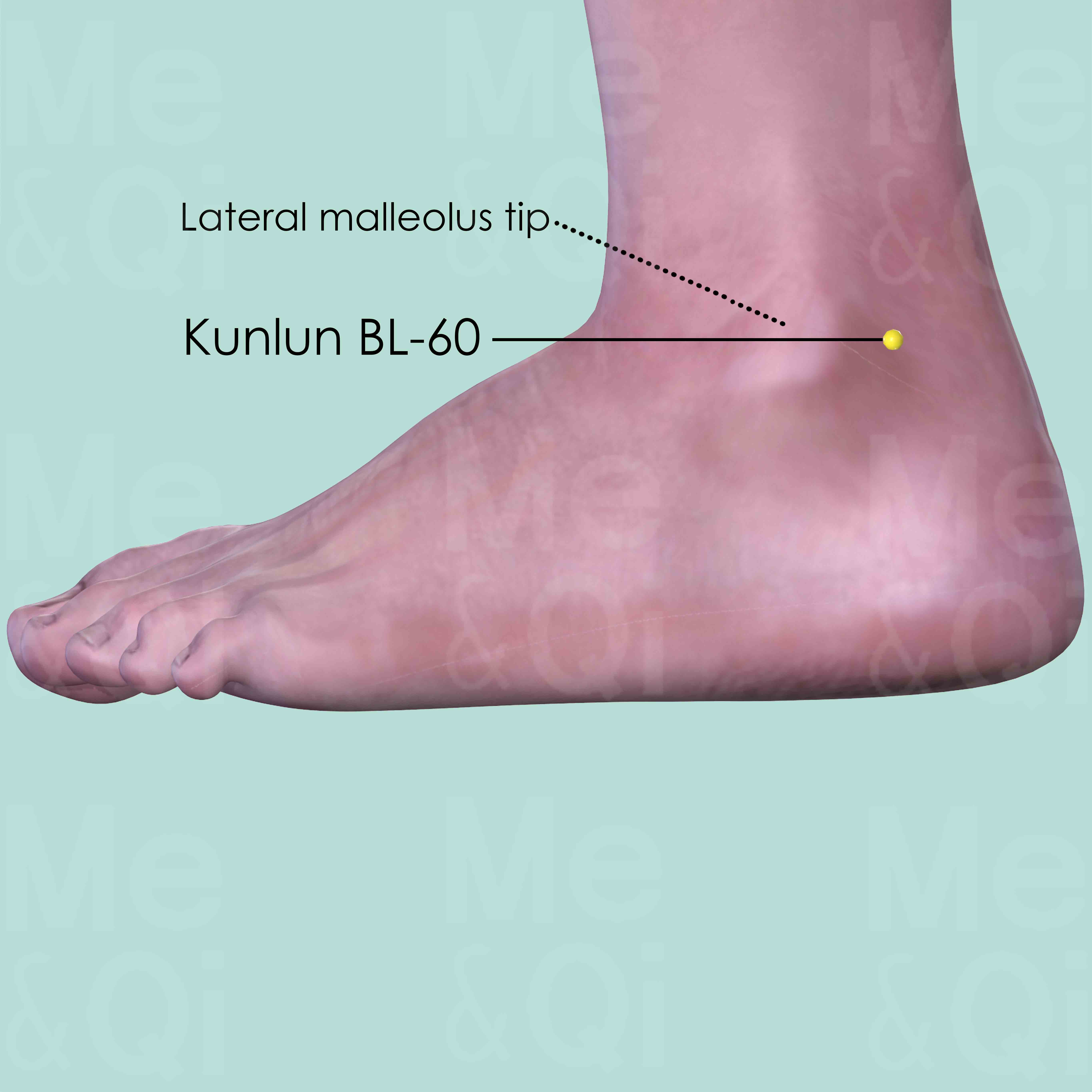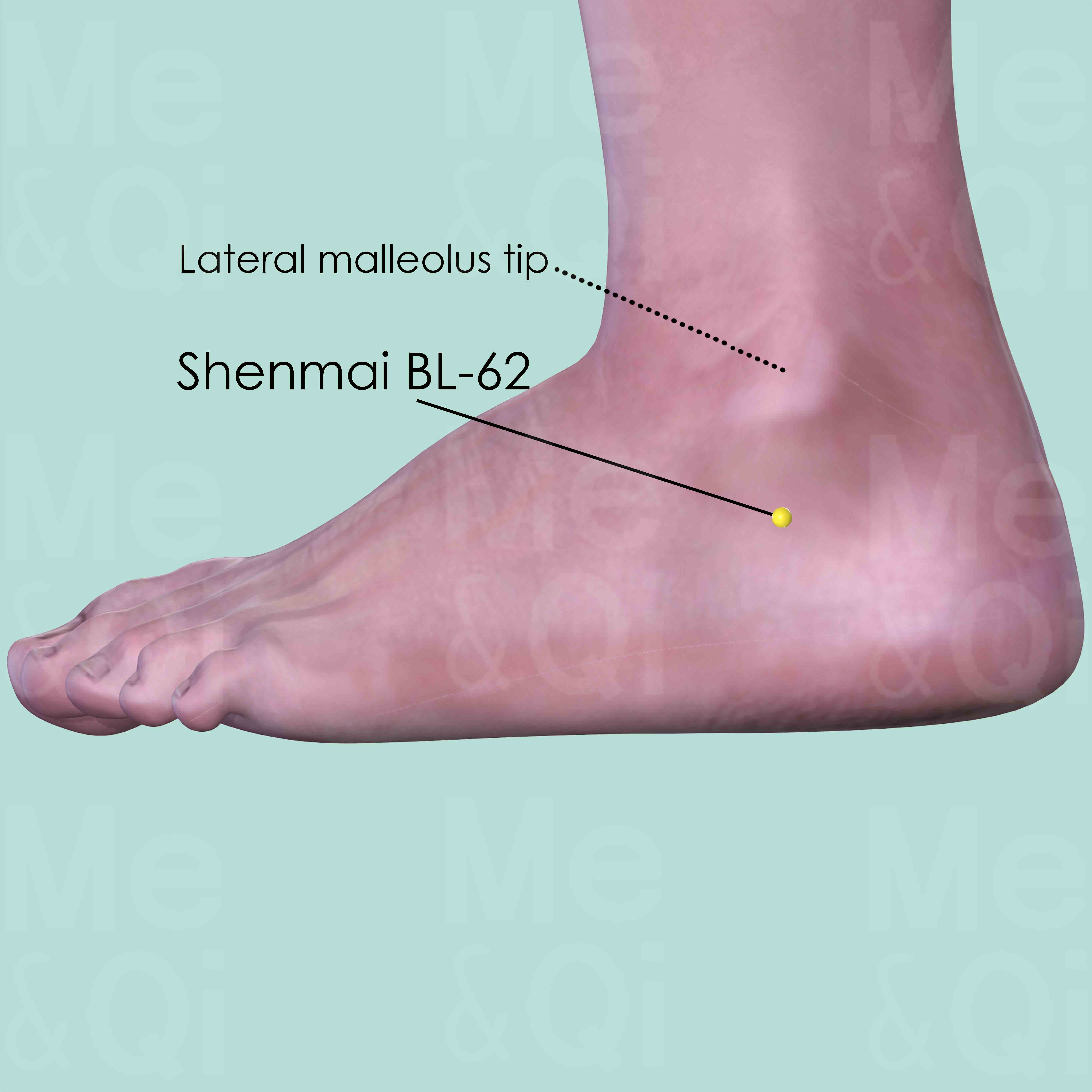Occipital Headacheaccording to TCM
What is Occipital Headache?
An occipital headache is characterized by persistent pain at the base of the skull that sometimes radiates toward the neck. This type of headache is recognized by TCM as a distinct pattern within the broader category of headaches, known for its location and unique attributes which can significantly impact an individual's quality of life.
How does TCM view Occipital Headaches
In TCM, occipital headaches are not seen as isolated symptoms but as signals of an underlying imbalance. The holistic approach of TCM aims to identify the root cause or 'pattern' of disharmony causing the headache. Recognizing the correct pattern is vital, as it guides the personalized treatment plan, focusing on restoring harmony and balance within the body.
Root Causes of Occipital Headache in TCM
TCM attributes occipital headaches to several patterns, often related to the invasion of Wind, the presence of Cold, or a deficiency of Yin. For instance, the Greater Yang Attack of Wind can manifest as occipital headaches with accompanying symptoms like stiffness in the neck and a slight aversion to cold.
Similarly, Wind-Cold pattern may present with a stiff occiput, sneezing, and nasal congestion. The treatment in TCM revolves around dispelling Wind, warming the channels, and nourishing the deficient energies to alleviate symptoms.
Explore below more details about what might cause Occipital headache according to TCM.
Wind
In TCM "Wind" is a concept that represents a pattern of disharmony, often characterized by its sudden and unpredictable nature, much like a gusty wind changing direction without warning. This pattern is associated with symptoms that come and go quickly or move around the body, such as itching, tremors, or even certain types of pain. Wind is considered to be a primary cause of illnesses that have these rapidly changing characteristics. In TCM, external Wind often refers to illnesses that start suddenly, like the common cold, believed to be caused by external pathogenic factors like climatic changes. On the other hand, internal Wind can be linked to internal imbalances and can manifest in conditions like dizziness or spasms. ... see more
Wind Patterns That Can Lead to Occipital Headache
Common Symptoms: Sneezing Anemophobia Aversion To Cold Fever Coughing Nasal Discharge Occipital Stiffness Congested Nose
| Pattern Name | Relevant Symptoms | Relevant Formulas |
|---|---|---|
| Greater Yang Attack of Wind | Occipital headaches, Slight aversion to cold, Anemophobia, Low grade fever, Mild sweating, Stiff neck, Sneezing, Occipital headache... see more | Gui Zhi Tang |
| Wind-Cold | Occipital headaches, Aversion to cold, Fever, Sneezing, Coughing, Nasal discharge, Occipital headache, Occipital stiffness, Congested nose, White and watery sputum... see more | Ma Huang Tang | Jing Fang Bai Du San | Cong Chi Tang | Huo Ren Cong Shi Tang | Jiu Wei Qiang Huo Tang | Jia Wei Xiang Su San | Shi Shen Tang | Jin Fei Cao San | Wu Ji San |
| Wind-Heat | Occipital headaches, Aversion to cold, Fever, Sneezing, Coughing, Nasal discharge, Occipital stiffness, Occipital headache, Perspiration, Sore throat, Yellowish phlegm... see more | Cong Chi Tang | Huo Ren Cong Shi Tang | Yin Qiao San | Sang Ju Yin | Jing Jie Lian Qiao Tang | Zhu Ye Cheng Liu Tang | Xiao Feng San | Fang Feng Tong Sheng San | Bing Peng San | Pu Ji Xiao Du Yin |
Cold
In TCM "Cold" as a pattern of disharmony refers to a specific type of imbalance within the body's systems, often linked to a deficiency or weakness. It's not about feeling physically cold or having a common cold, but rather a metaphorical description of certain symptoms and underlying conditions. When a TCM practitioner says someone suffers from "Cold," it usually implies that the body's Yang energy, which is warm and active, is insufficient or overpowered by Yin energy, which is cool and passive. Symptoms of Cold in TCM can include a general feeling of coldness, cold limbs, pale complexion, low energy, slow metabolism, and a preference for warmth. ... see more
Cold Patterns That Can Lead to Occipital Headache
Common Symptoms: Aversion To Cold Lack Of Sweating Sneezing Nasal Discharge Low Grade Fever Stiff Neck Shortness Of Breath Fever
| Pattern Name | Relevant Symptoms | Relevant Formulas |
|---|---|---|
| Greater Yang Attack of Cold | Occipital headaches, Occipital headache, Aversion to cold, Low grade fever, Lack of sweating, Stiff neck, Sneezing, Nasal discharge, Shortness of breath... see more | Ma Huang Tang |
| Wind-Cold | Occipital headaches, Aversion to cold, Fever, Sneezing, Coughing, Nasal discharge, Occipital headache, Occipital stiffness, Congested nose, White and watery sputum... see more | Ma Huang Tang | Jing Fang Bai Du San | Cong Chi Tang | Huo Ren Cong Shi Tang | Jiu Wei Qiang Huo Tang | Jia Wei Xiang Su San | Shi Shen Tang | Jin Fei Cao San | Wu Ji San |
Yin Deficiency
Yin deficiency in TCM is a pattern of disharmony characterized by a depletion of the body's Yin energy, which represents the cooling, moistening, and nurturing aspects of our physiology. This condition often arises from factors like chronic stress, overwork, insufficient rest, or prolonged illness. Symptoms of Yin deficiency can include a sensation of heat, especially in the afternoon or evening, night sweats, insomnia, a dry mouth or throat, and a red tongue with little coating. There might also be a general feeling of restlessness or irritability. Since Yin is essential for balancing the body's active and warm Yang energy, its deficiency leads to a relative excess of Yang, manifesting as heat or dryness symptoms.... see more
Yin Deficiency Patterns That Can Lead to Occipital Headache
| Pattern Name | Relevant Symptoms | Relevant Formulas |
|---|---|---|
| Kidney and Liver Yin Deficiency | Occipital headaches, Dizziness, Tinnitus, Hearing loss, Lower back pain, Vertical headaches, Occipital headache, Insomnia, Limb numbness, Tingling of limbs, Dry eyes, Blurry vision, Dry throat, Dry hair, Skin dryness, Withered and brittle nails, Vaginal dryness, Night sweats, Dry stools, Nocturnal emission, Scanty menstruation, Amenorrhea, Late menstruation, Infertility... see more | Zuo Gui Wan | Qi Ju Di Huang Wan | Liu Wei Di Huang Wan | Qing Gu San | Yi Guan Jian |
Heat
In TCM "Heat" signifies an excess of Yang energy, leading to an imbalance where heat predominates over the body's cool Yin aspects. This condition is metaphorically akin to an internal over-heating. Symptoms indicative of Heat can include feelings of warmth, fever, sweating, irritability, red face, thirst with a preference for cold drinks, and a rapid pulse. The tongue may appear red with a yellow coating. Unlike the common interpretation of heat in terms of temperature, in TCM, it represents a state of hyperactivity or inflammation in the body.... see more
Heat Patterns That Can Lead to Occipital Headache
| Pattern Name | Relevant Symptoms | Relevant Formulas |
|---|---|---|
| Wind-Heat | Occipital headaches, Aversion to cold, Fever, Sneezing, Coughing, Nasal discharge, Occipital stiffness, Occipital headache, Perspiration, Sore throat, Yellowish phlegm... see more | Cong Chi Tang | Huo Ren Cong Shi Tang | Yin Qiao San | Sang Ju Yin | Jing Jie Lian Qiao Tang | Zhu Ye Cheng Liu Tang | Xiao Feng San | Fang Feng Tong Sheng San | Bing Peng San | Pu Ji Xiao Du Yin |
Kidney
In TCM the Kidneys are regarded as the body's most fundamental reservoir of Essence, known as Jing, which influences growth, reproduction, and aging. They are not just organs for filtering blood, but a holistic system governing vital life forces. When the Kidneys malfunction in TCM, it can manifest as a variety of health issues, such as chronic fatigue, reproductive problems, imbalances in fluid metabolism leading to edema or dryness, lower back pain, and a sense of fear or insecurity.... see more
Kidney Patterns That Can Lead to Occipital Headache
| Pattern Name | Relevant Symptoms | Relevant Formulas |
|---|---|---|
| Kidney and Liver Yin Deficiency | Occipital headaches, Dizziness, Tinnitus, Hearing loss, Lower back pain, Vertical headaches, Occipital headache, Insomnia, Limb numbness, Tingling of limbs, Dry eyes, Blurry vision, Dry throat, Dry hair, Skin dryness, Withered and brittle nails, Vaginal dryness, Night sweats, Dry stools, Nocturnal emission, Scanty menstruation, Amenorrhea, Late menstruation, Infertility... see more | Zuo Gui Wan | Qi Ju Di Huang Wan | Liu Wei Di Huang Wan | Qing Gu San | Yi Guan Jian |
Liver
In TCM the Liver is viewed as the organ responsible for the smooth flow of Qi, Blood, and emotions throughout the body. It plays a key role in regulating mood, storing blood, supporting digestion, and ensuring the health of tendons and eyes. When the Liver malfunctions or is imbalanced in TCM, it can lead to a range of issues such as irritability, mood swings, menstrual irregularities, eye problems, and muscular stiffness or pain. A malfunctioning Liver in TCM reflects not only physical disturbances but also emotional and mental disharmony, emphasizing the holistic approach of TCM in addressing health and wellness.... see more
Liver Patterns That Can Lead to Occipital Headache
| Pattern Name | Relevant Symptoms | Relevant Formulas |
|---|---|---|
| Kidney and Liver Yin Deficiency | Occipital headaches, Dizziness, Tinnitus, Hearing loss, Lower back pain, Vertical headaches, Occipital headache, Insomnia, Limb numbness, Tingling of limbs, Dry eyes, Blurry vision, Dry throat, Dry hair, Skin dryness, Withered and brittle nails, Vaginal dryness, Night sweats, Dry stools, Nocturnal emission, Scanty menstruation, Amenorrhea, Late menstruation, Infertility... see more | Zuo Gui Wan | Qi Ju Di Huang Wan | Liu Wei Di Huang Wan | Qing Gu San | Yi Guan Jian |
TCM Herbal Formulas for Occipital Headache
For occipital headaches arising from Wind-Cold patterns, TCM suggests formulas like Gui Zhi Tang, which uses Cinnamon Twigs to release the Exterior and dispel Wind. In cases where Cold attacks the Greater Yang channel, Ma Huang Tang, which includes Ephedra, warms the Interior and expels Cold. Each herbal prescription is tailored to address the specific TCM diagnosis, ensuring a targeted approach to treatment.
Explore below some TCM herbal formulas used to address occipital headache, organized by cause and by formula type.
- By Cause
- By Formula Type
- Wind
- Cold
- Yin Deficiency
- Heat
- View More Causes
- Formulas that clear wind-Cold
- Formulas that nourish yin and tonify
- External formulas for external disorders
- Formulas that clear wind-Heat
- Formulas that clear early-stage exterior disorders
- Formulas that clear heat from deficiency
- Formulas that release the exterior and warm the interior
- Formulas that dredge and disperse external wind
- Formulas that release the exterior and purge the interior
- Formulas that clear heat and resolve toxicity
Top Formula for Wind:
Cong Chi Tang
Suitable for Wind patterns that may cause occipital headache, such as Wind-Cold or Wind-Heat
Learn moreAll Formulas Recommended for Occipital Headache Caused by Wind
| Formula | Patterns Suitable For |
|---|---|
| Cong Chi Tang | Wind-Cold, Wind-Heat |
| Huo Ren Cong Shi Tang | Wind-Cold, Wind-Heat |
| Ma Huang Tang | Wind-Cold |
| Gui Zhi Tang | Greater Yang Attack of Wind |
| Jing Fang Bai Du San | Wind-Cold |
| Jiu Wei Qiang Huo Tang | Wind-Cold |
| Jia Wei Xiang Su San | Wind-Cold |
| Shi Shen Tang | Wind-Cold |
| Jin Fei Cao San | Wind-Cold |
| Wu Ji San | Wind-Cold |
| Yin Qiao San | Wind-Heat |
| Sang Ju Yin | Wind-Heat |
| Jing Jie Lian Qiao Tang | Wind-Heat |
| Zhu Ye Cheng Liu Tang | Wind-Heat |
| Xiao Feng San | Wind-Heat |
| Fang Feng Tong Sheng San | Wind-Heat |
| Bing Peng San | Wind-Heat |
| Pu Ji Xiao Du Yin | Wind-Heat |
Top Formula for Cold:
Ma Huang Tang
Suitable for Cold patterns that may cause occipital headache, such as Greater Yang Attack of Cold or Wind-Cold
Learn moreAll Formulas Recommended for Occipital Headache Caused by Cold
| Formula | Patterns Suitable For |
|---|---|
| Ma Huang Tang | Greater Yang Attack of Cold, Wind-Cold |
| Cong Chi Tang | Wind-Cold |
| Huo Ren Cong Shi Tang | Wind-Cold |
| Jing Fang Bai Du San | Wind-Cold |
| Jiu Wei Qiang Huo Tang | Wind-Cold |
| Jia Wei Xiang Su San | Wind-Cold |
| Shi Shen Tang | Wind-Cold |
| Jin Fei Cao San | Wind-Cold |
| Wu Ji San | Wind-Cold |
Top Formula for Yin Deficiency:
Zuo Gui Wan
Suitable for Yin Deficiency patterns that may cause occipital headache, such as Kidney and Liver Yin Deficiency
Learn moreAll Formulas Recommended for Occipital Headache Caused by Yin Deficiency
| Formula | Patterns Suitable For |
|---|---|
| Zuo Gui Wan | Kidney and Liver Yin Deficiency |
| Qi Ju Di Huang Wan | Kidney and Liver Yin Deficiency |
| Liu Wei Di Huang Wan | Kidney and Liver Yin Deficiency |
| Qing Gu San | Kidney and Liver Yin Deficiency |
| Yi Guan Jian | Kidney and Liver Yin Deficiency |
Top Formula for Heat:
Cong Chi Tang
Suitable for Heat patterns that may cause occipital headache, such as Wind-Heat
Learn moreAll Formulas Recommended for Occipital Headache Caused by Heat
| Formula | Patterns Suitable For |
|---|---|
| Cong Chi Tang | Wind-Heat |
| Huo Ren Cong Shi Tang | Wind-Heat |
| Yin Qiao San | Wind-Heat |
| Sang Ju Yin | Wind-Heat |
| Jing Jie Lian Qiao Tang | Wind-Heat |
| Zhu Ye Cheng Liu Tang | Wind-Heat |
| Xiao Feng San | Wind-Heat |
| Fang Feng Tong Sheng San | Wind-Heat |
| Bing Peng San | Wind-Heat |
| Pu Ji Xiao Du Yin | Wind-Heat |
Formulas that clear Wind-Cold
These formulas are suitable for some occipital headache-causing patterns like Greater Yang Attack of Cold or Wind-Cold.
One such formula is Ma Huang Tang, with ephedra as a key herb.
Other formulas of this category are listed in the table below.
All "formulas that clear wind-Cold" recommended for occipital headache
| Formula | Patterns Suitable For (if applicable) |
|---|---|
| Ma Huang Tang | Greater Yang Attack of Cold, Wind-Cold |
| Gui Zhi Tang | Greater Yang Attack of Wind |
| Jiu Wei Qiang Huo Tang | Wind-Cold |
| Jia Wei Xiang Su San | Wind-Cold |
| Shi Shen Tang | Wind-Cold |
| Jin Fei Cao San | Wind-Cold |
External formulas for External disorders
These formulas are suitable for some occipital headache-causing patterns like Wind-Cold.
One such formula is Jing Fang Bai Du San, with japanese catnip as a key herb.
Other formulas of this category are listed in the table below.
All "external formulas for external disorders" recommended for occipital headache
| Formula | Patterns Suitable For (if applicable) |
|---|---|
| Jing Fang Bai Du San | Wind-Cold |
| Yin Qiao San | Wind-Heat |
| Bing Peng San | Wind-Heat |
Formulas that clear early-stage Exterior disorders
These formulas are suitable for some occipital headache-causing patterns like Wind-Cold or Wind-Heat.
One such formula is Cong Chi Tang, with scallions as a key herb.
Other formulas of this category are listed in the table below.
All "formulas that clear early-stage exterior disorders" recommended for occipital headache
| Formula | Patterns Suitable For (if applicable) |
|---|---|
| Cong Chi Tang | Wind-Cold, Wind-Heat |
| Huo Ren Cong Shi Tang | Wind-Cold, Wind-Heat |
Formulas that nourish Yin and tonify
These formulas are suitable for some occipital headache-causing patterns like Kidney and Liver Yin Deficiency.
One such formula is Zuo Gui Wan, with prepared rehmannia as a key herb.
Other formulas of this category are listed in the table below.
All "formulas that nourish yin and tonify" recommended for occipital headache
| Formula | Patterns Suitable For (if applicable) |
|---|---|
| Zuo Gui Wan | Kidney and Liver Yin Deficiency |
| Qi Ju Di Huang Wan | Kidney and Liver Yin Deficiency |
| Liu Wei Di Huang Wan | Kidney and Liver Yin Deficiency |
| Yi Guan Jian | Kidney and Liver Yin Deficiency |
Formulas that clear Wind-Heat
These formulas are suitable for some occipital headache-causing patterns like Wind-Heat.
One such formula is Sang Ju Yin, with mulberry leaves as a key herb.
Other formulas of this category are listed in the table below.
All "formulas that clear wind-Heat" recommended for occipital headache
| Formula | Patterns Suitable For (if applicable) |
|---|---|
| Sang Ju Yin | Wind-Heat |
| Jing Jie Lian Qiao Tang | Wind-Heat |
| Zhu Ye Cheng Liu Tang | Wind-Heat |
Formulas that clear Heat from Deficiency
These formulas are suitable for some occipital headache-causing patterns like Kidney and Liver Yin Deficiency.
One such formula is Qing Gu San, with stellaria root as a key herb.
Formulas that dredge and disperse External Wind
These formulas are suitable for some occipital headache-causing patterns like Wind-Heat.
One such formula is Xiao Feng San, with japanese catnip as a key herb.
Formulas that release the Exterior and purge the Interior
These formulas are suitable for some occipital headache-causing patterns like Wind-Heat.
One such formula is Fang Feng Tong Sheng San, with saposhnikovia root as a key herb.
Formulas that clear Heat and resolve toxicity
These formulas are suitable for some occipital headache-causing patterns like Wind-Heat.
One such formula is Pu Ji Xiao Du Yin, with baikal skullcap root as a key herb.
Acupoints for Occipital Headache
TCM also prescribes acupuncture as a method to relieve occipital headaches. Points along the Bladder Channel, like Fengchi (GB-20), located at the nape of the neck, are often selected for their effectiveness in treating headaches by clearing Wind and easing tension. Dazhui (DU-14) is another crucial point that is believed to clear Wind-Heat and release the Exterior, providing relief from pain.
Explore below some acupoints used to address occipital headache, organized by meridian.
- By Meridian
- Bladder Channel
- Governing Vessel
- Small Intestine Channel
- Gall Bladder Channel
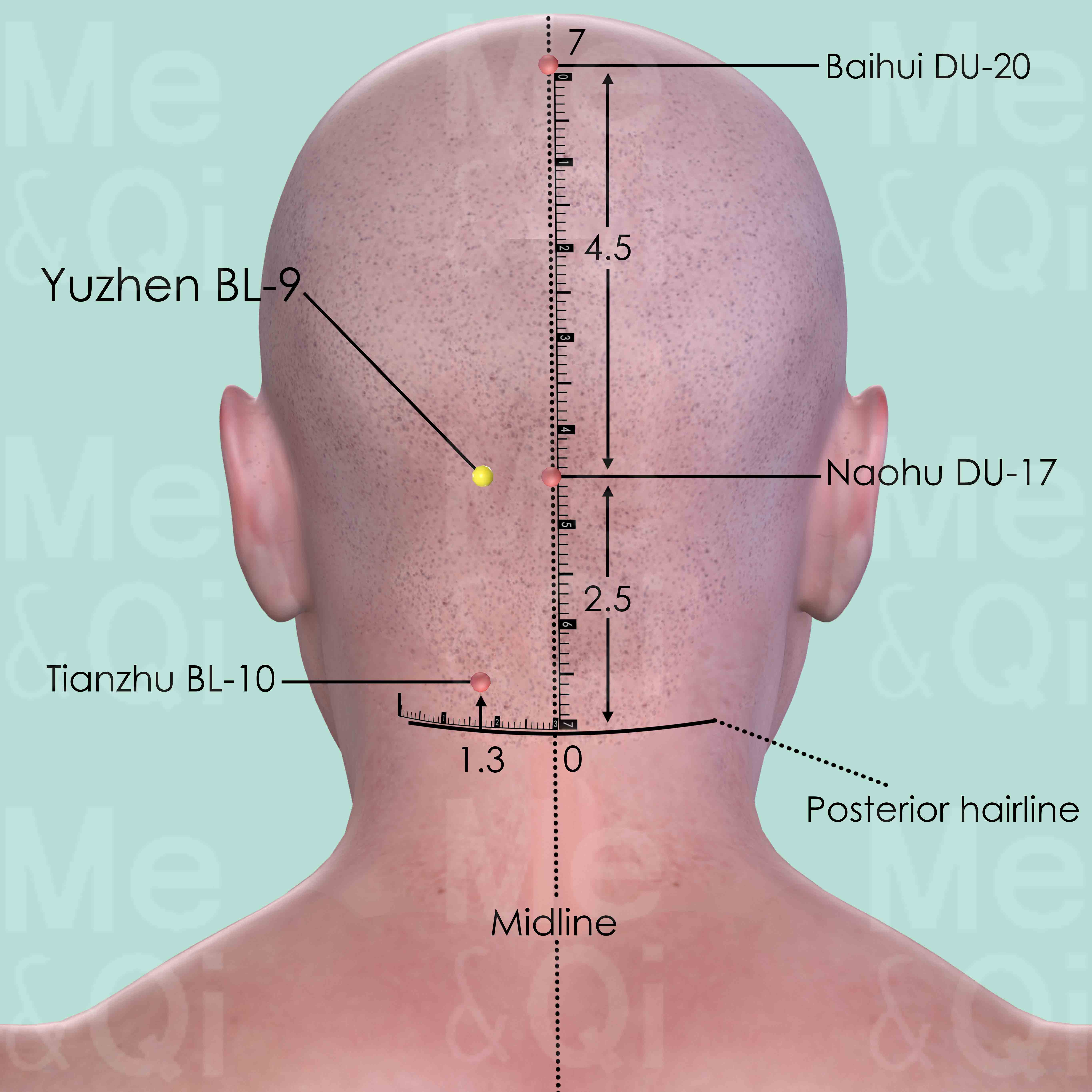
Yuzhen BL-9
First identify Naohu DU-17 which is on the superior border of the external occipital protuberance. Yuzhen BL-9 is 1.3 cun lateral to Naohu DU-17.
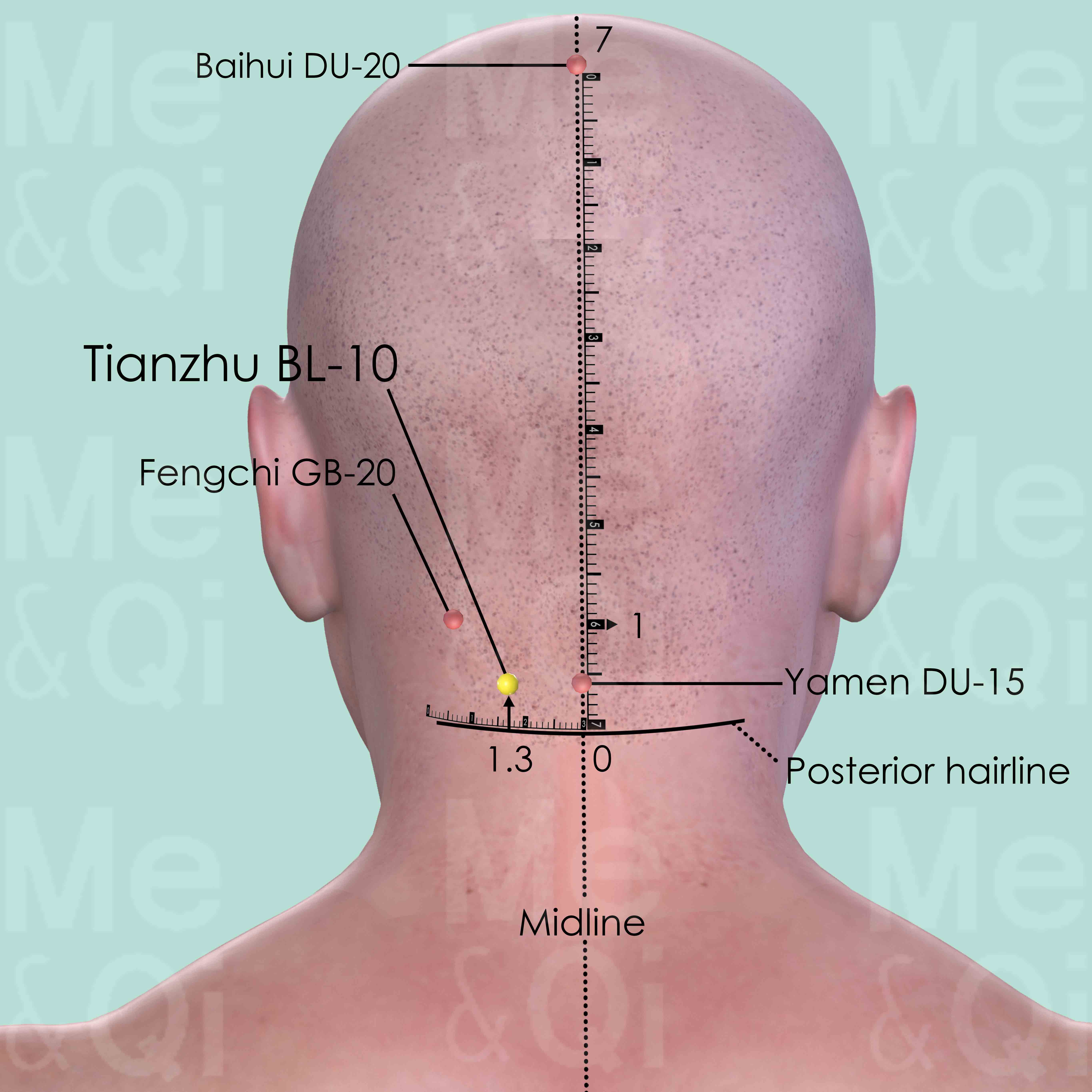
Tianzhu BL-10
1.3 cun lateral to Yamen DU-15 on the posterior midline, 0.5 cun above the posterior hairline, on the lateral side of trapezius muscle.
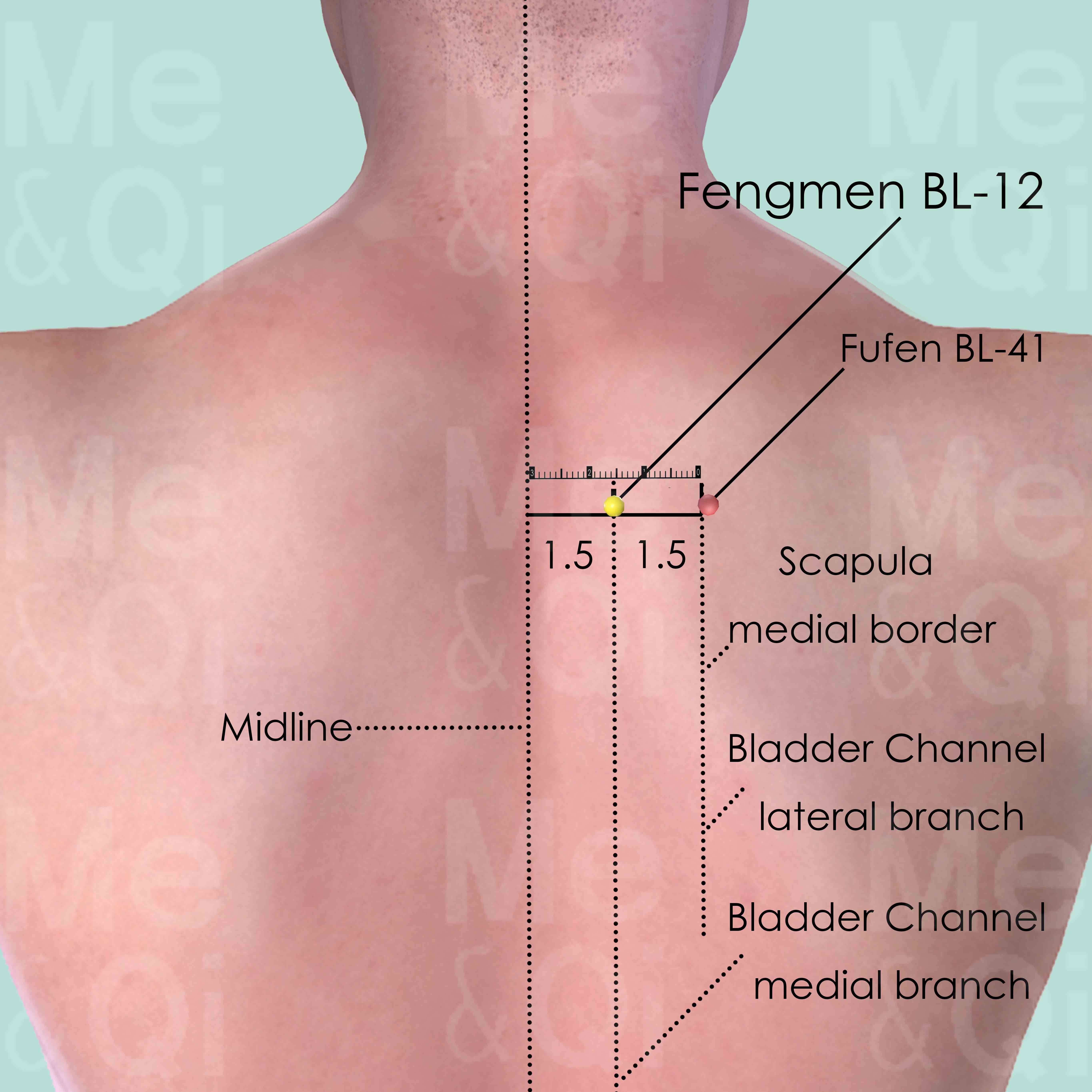
Fengmen BL-12
1.5 cun lateral to the lower border of the spinous process of the 2nd thoracic vertebra (T2).
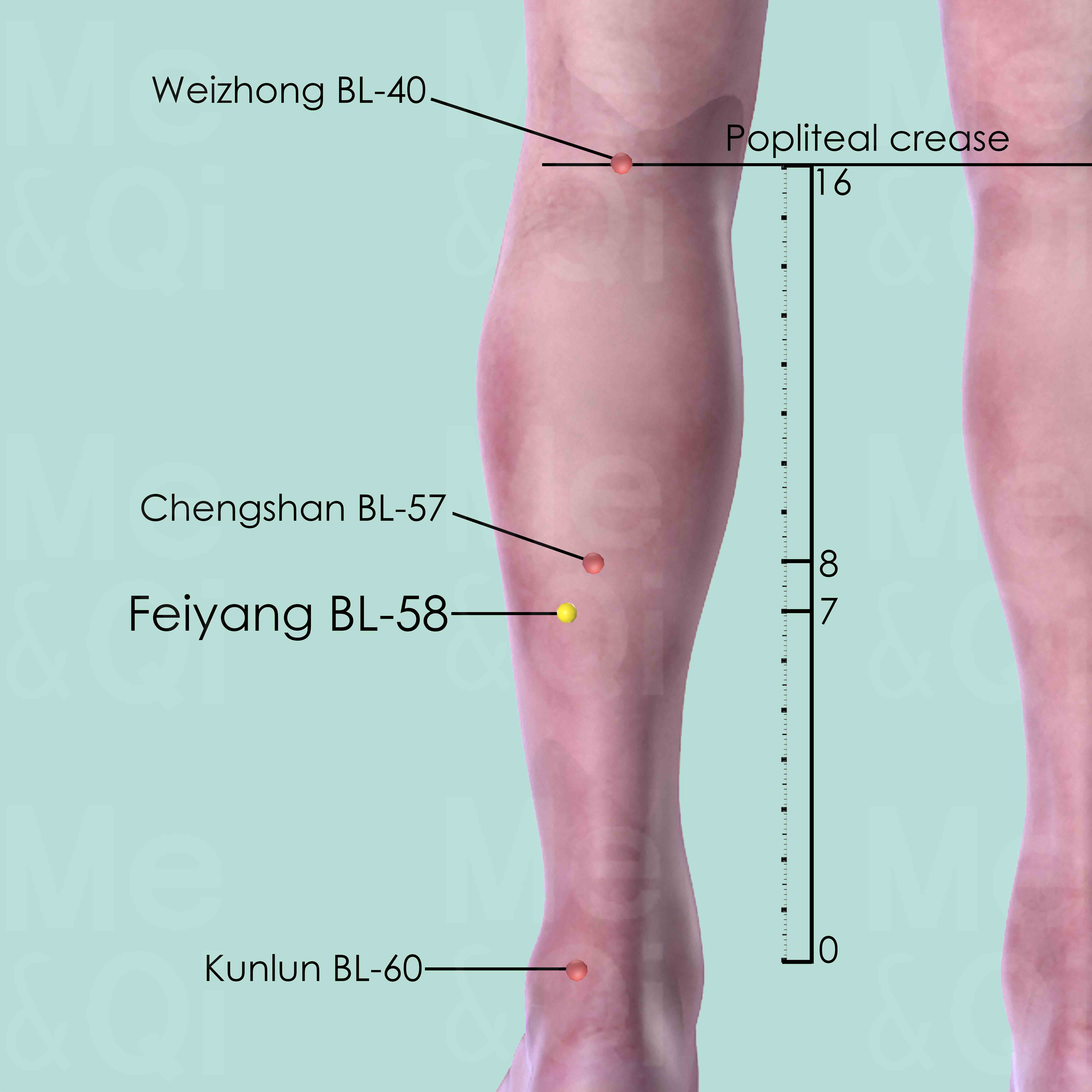
Feiyang BL-58
On the posterior border of fibula, about 1 cun inferior and lateral to Chengshan BL-57, 7 cun directly above Kunlun BL-60.
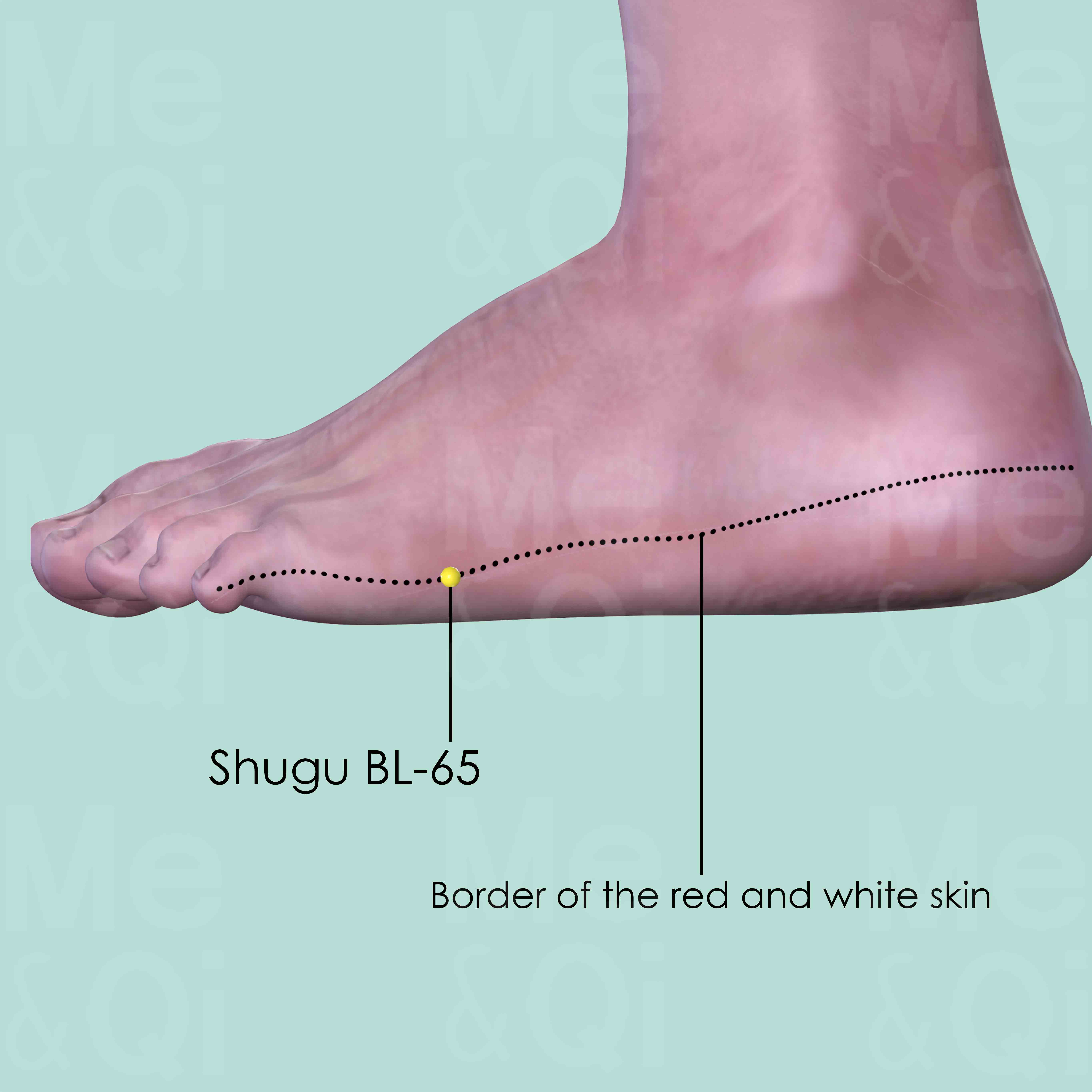
Shugu BL-65
On the lateral side of the foot dorsum, proximal to the head of the 5th metatarsal bone, at the border of the red and white skin.
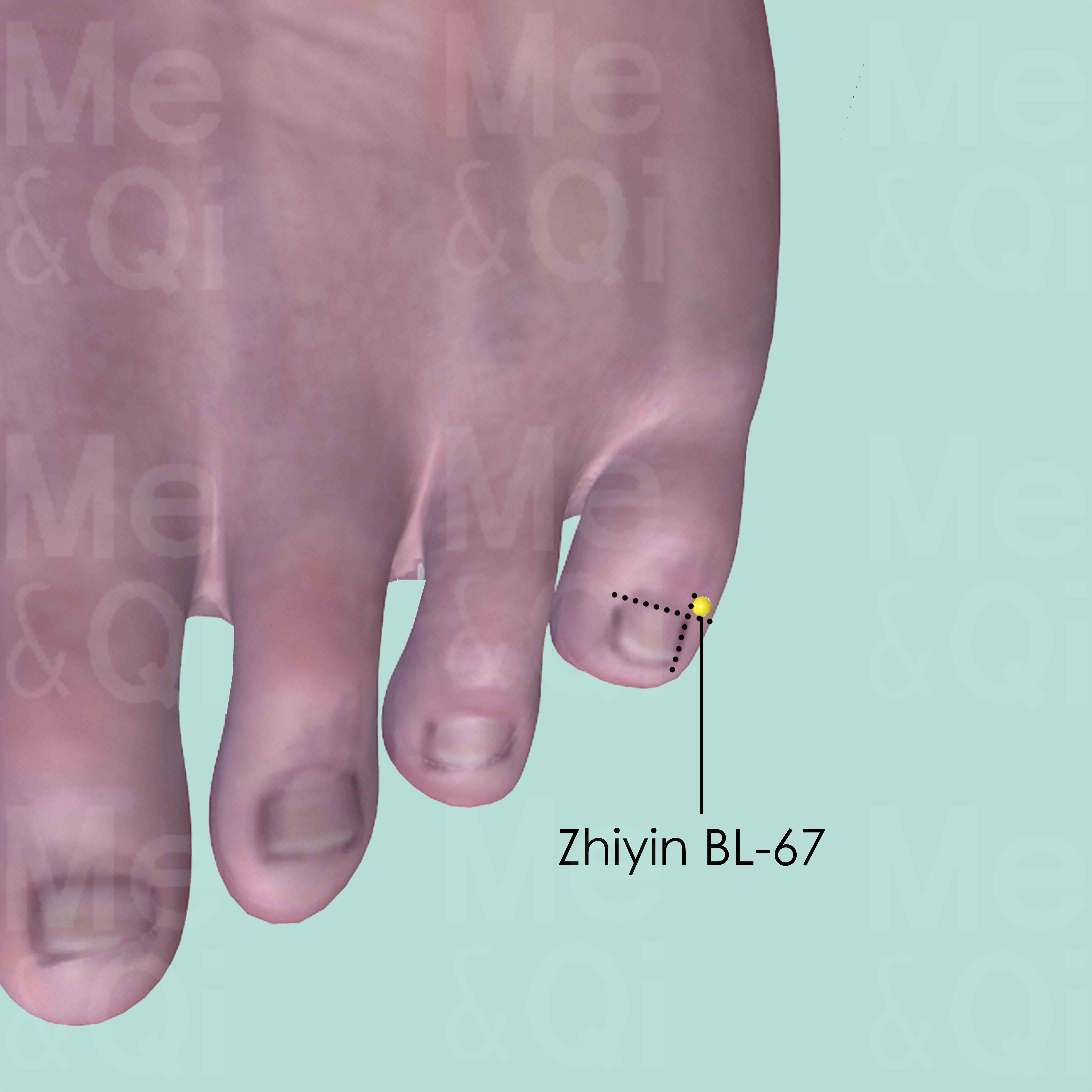
Zhiyin BL-67
On the lateral side of the little toe, about 0.1 cun posterior to the corner of the nail.
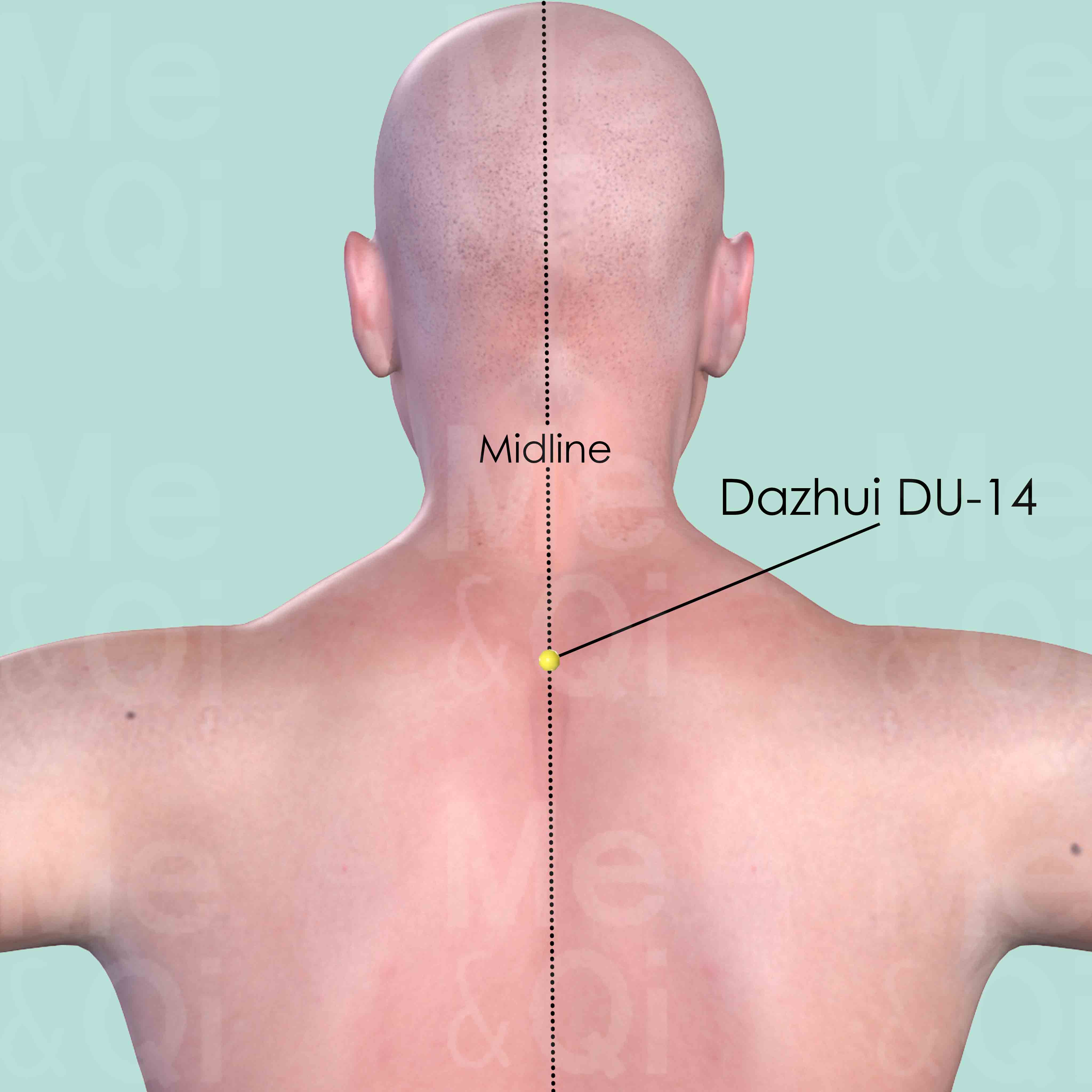
Dazhui DU-14
On the midline at the base of the neck, in the depression below the spinous process of the seventh cervical vertebra (C7).
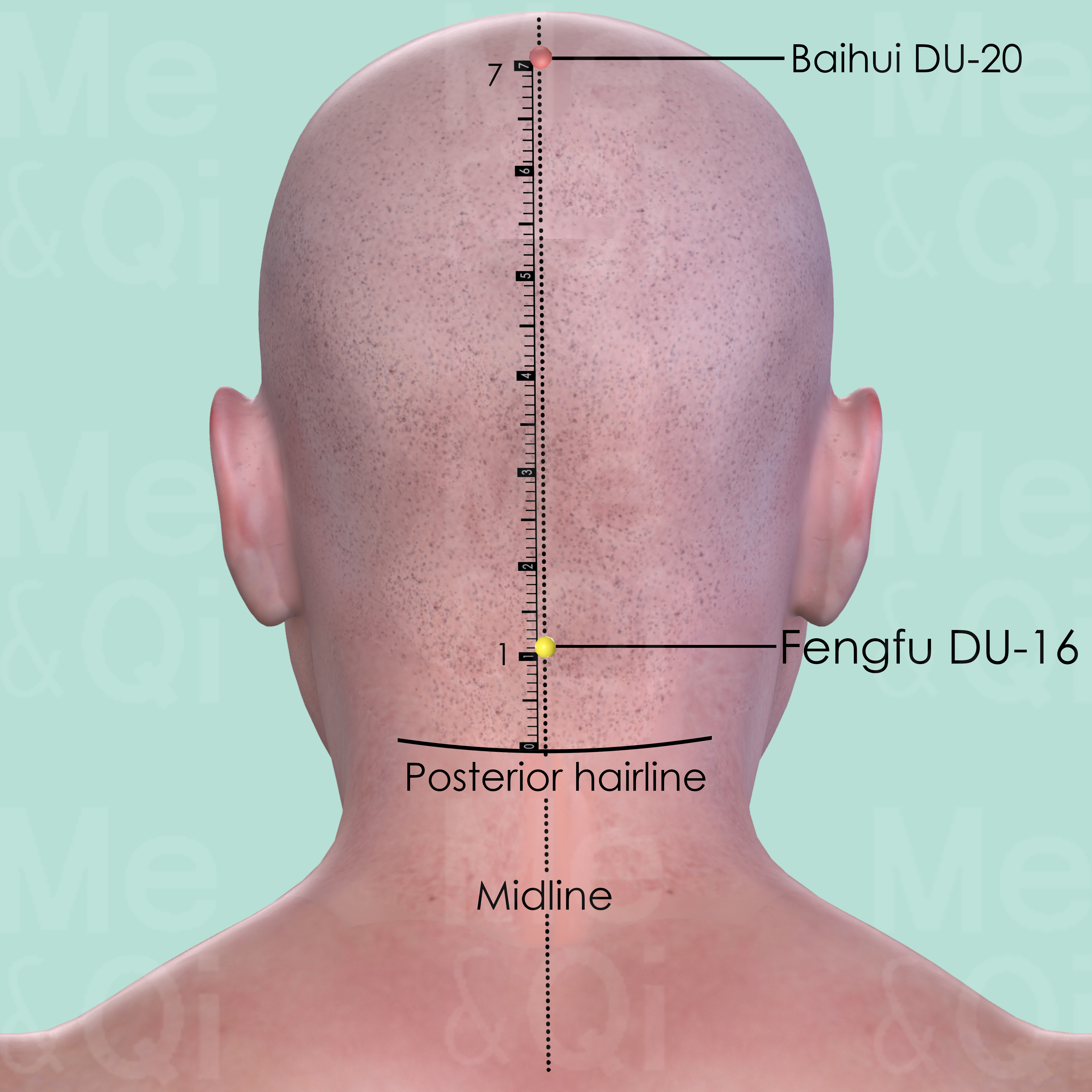
Fengfu DU-16
Directly below the external occipital protuberance, in the depression between the origins of the trapezius muscle.
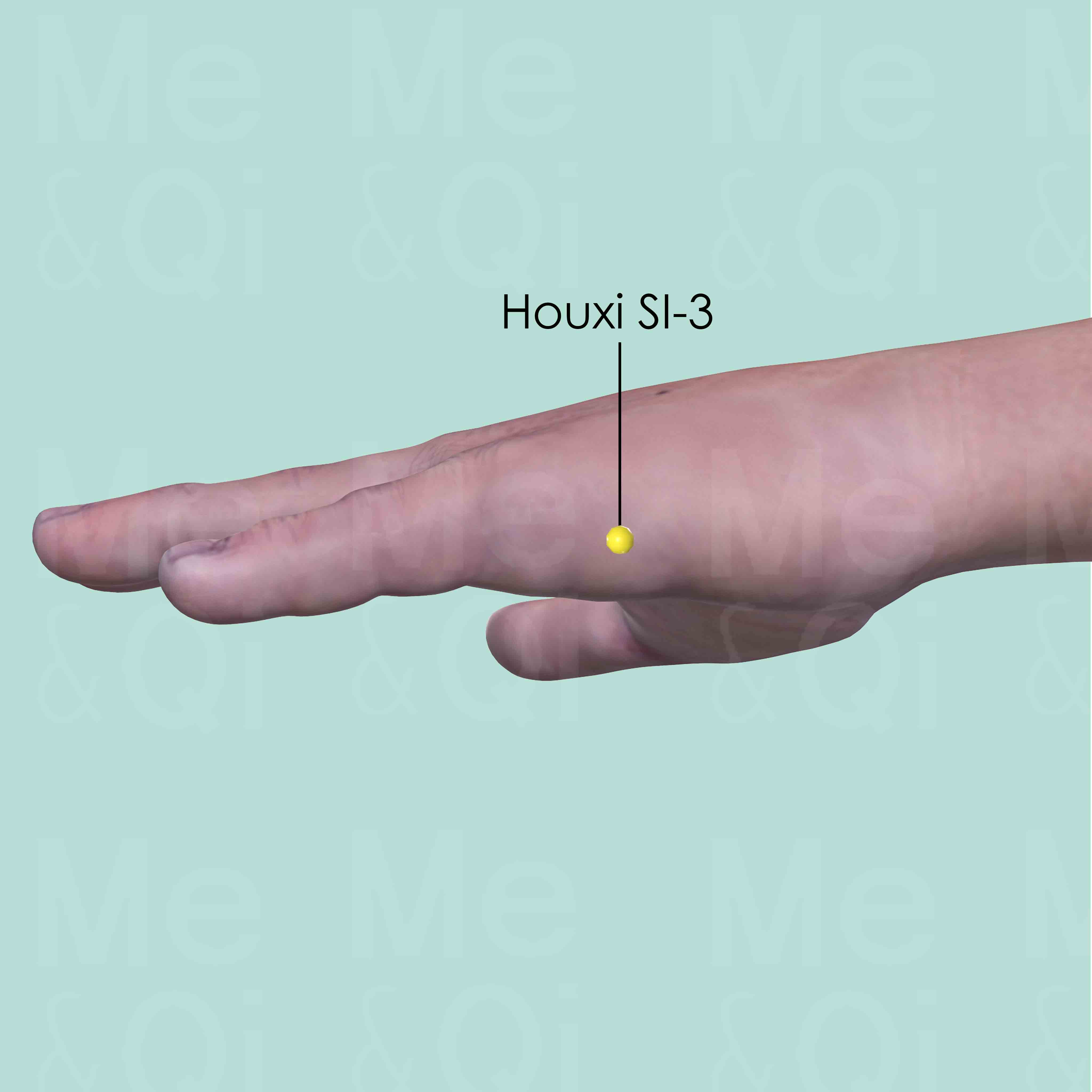
Houxi SI-3
Proximal to the head of the 5th metacarpal bone on the ulnar side, in the depression at the junction of the red and white skin.
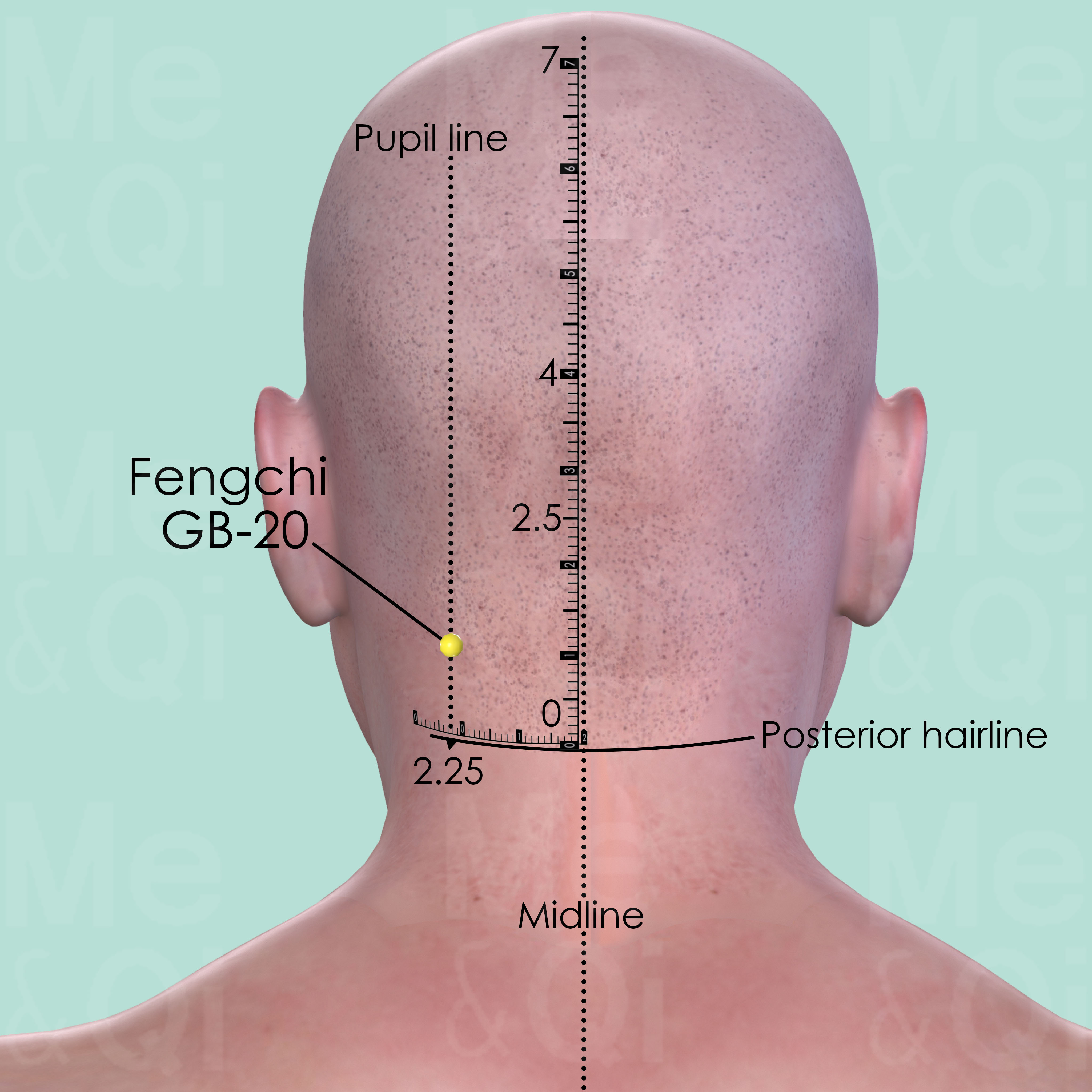
Fengchi GB-20
In the posterior aspect of the neck, below the occipital bone, in the depression between the upper portion of sternocleidomastoid and trapezius muscle.

